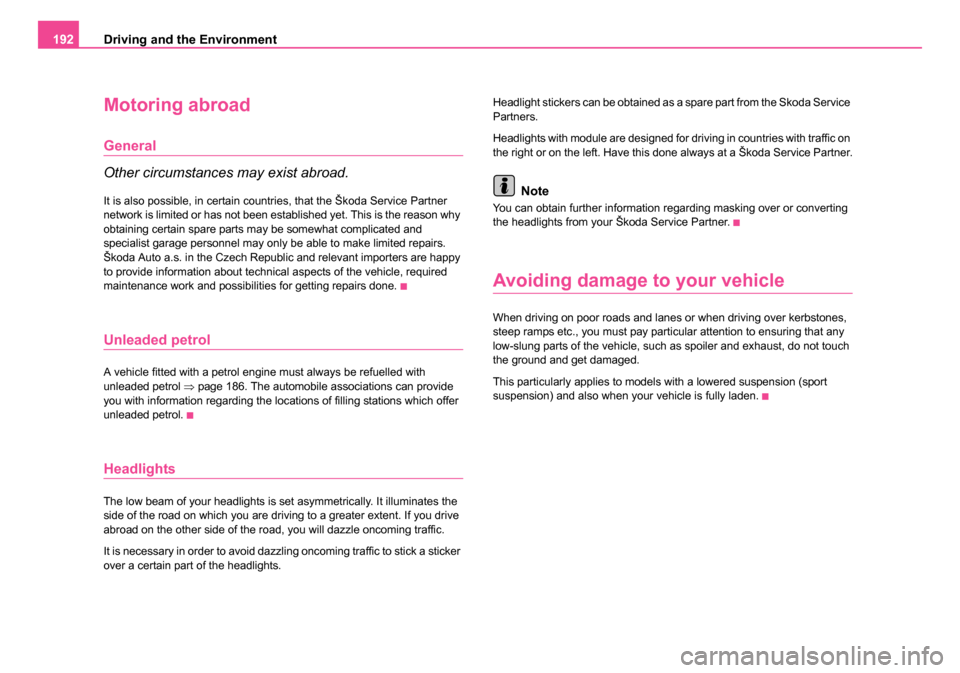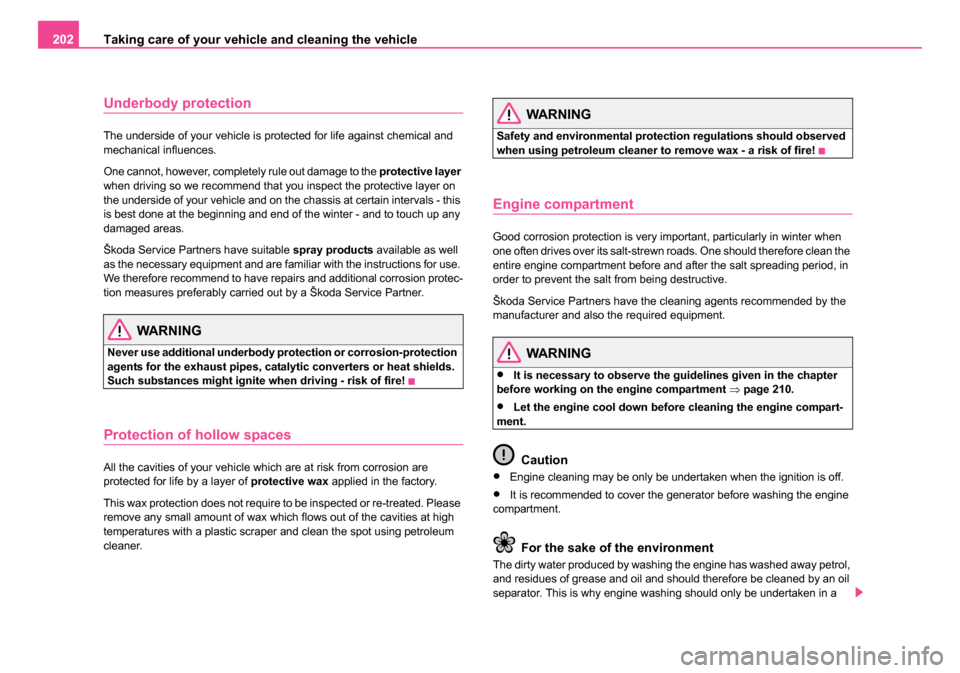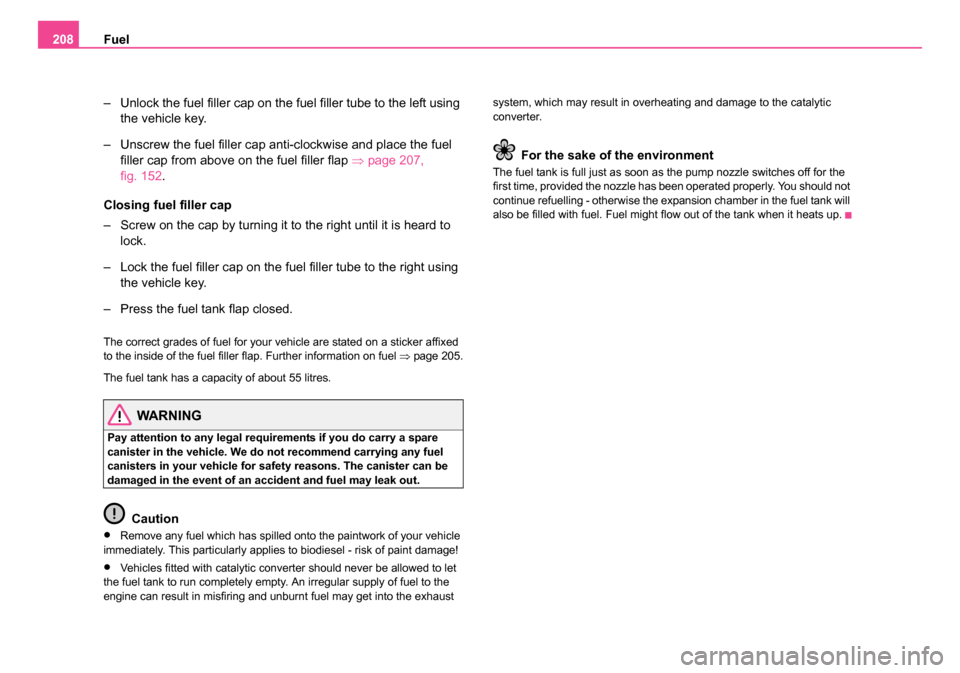2006 SKODA ROOMSTER engine
[x] Cancel search: enginePage 193 of 274

Driving and the Environment
192
Motoring abroad
General
Other circumstances may exist abroad.
It is also possible, in certain countries, that the Škoda Service Partner
network is limited or has not been established yet. This is the reason why
obtaining certain spare parts may be somewhat complicated and
specialist garage personnel may only be able to make limited repairs.
Škoda Auto a.s. in the Czech Republic and relevant importers are happy
to provide information about technical aspects of the vehicle, required
maintenance work and possibilities for getting repairs done.
Unleaded petrol
A vehicle fitted with a petrol engine must always be refuelled with
unleaded petrol ⇒page 186. The automobile associations can provide
you with information regarding the locations of filling stations which offer
unleaded petrol.
Headlights
The low beam of your headlights is set asymmetrically. It illuminates the
side of the road on which you are driving to a greater extent. If you drive
abroad on the other side of the road, you will dazzle oncoming traffic.
It is necessary in order to avoid dazzling oncoming traffic to stick a sticker
over a certain part of the headlights. Headlight stickers can be obtained as a spare part from the Skoda Service
Partners.
Headlights with module are designed for driving in countries with traffic on
the right or on the left. Have this done always at a Škoda Service Partner.
Note
You can obtain further information regarding masking over or converting
the headlights from your Škoda Service Partner.
Avoiding damage to your vehicle
When driving on poor roads and lanes or when driving over kerbstones,
steep ramps etc., you must pay particular attention to ensuring that any
low-slung parts of the vehicle, such as spoiler and exhaust, do not touch
the ground and get damaged.
This particularly applies to models with a lowered suspension (sport
suspension) and also when your vehicle is fully laden.
NKO 20 A05.book Page 192 Wednesday, June 21, 2006 1:42 PM
Page 194 of 274

Towing a trailer193
Using the systemSafetyDriving TipsGeneral MaintenanceBreakdown assistanceTechnical Data
Towing a trailer
Towing a trailer
Technical requirements
The towing device must satisfy certain technical require-
ments.
Your vehicle is designed primarily for transporting persons and luggage. It
can, however, also be used for towing a trailer - provided certain technical
equipment is fitted.
If your vehicle has already been supplied with a factory-fitted towing
device then everything that is necessary for towing a trailer in technical
terms, and in terms of the law, has already been taken into account.
Your vehicle is fitted with a 13-pin power socket for the electrical connec-
tion between the vehicle and trailer. If the trailer which you wish to tow has
a 7-pin connector , you can use a suitable adapter
5) from Škoda original
accessories.
This work must be carried out in accordance with the manufacturer's
specifications if a towing device is retrofitted.
Škoda Service Partners are familiar with details relating to retrofitting a
towing device and for any necessary modifications to the cooling system.
WARNING
We recommend that you have the towing device from Škoda orig-
inal accessories installed by a Škoda Service Partner. He is familiar
with all the relevant details relating to retrofitting such equipment.
There is a risk of an accident if the towing device is not properly
fitted!
General Maintenance
There are a number of points to pay attention to when
towing a trailer.
Tr a i l e r l o a d
The permissible trailer load must on no account be exceeded.
You can negotiate appropriately steeper inclines and descents if you do
not make full use of the permissible trailer load.
The trailer loads specified only apply for altitudes up to 1 000 metres
above mean sea level. The fact that the engine power output drops with
increasing height due to a lowering of air pressure and thus the ability to
climb, means that the towed weight must be reduced by 10% for every
further increase of 1 000 metres in height above sea level. The towed
weight is the weight of the (laden) vehicle and the (laden) trailer together.
One should take this into account before driving up to higher altitudes.
The trailer and drawbar load information on the type plate of the
towing device are merely test data for the towing device The data
relating to your vehicle, which is often less than this test data, can
5)In some countries the adapter is supplied with the towing device.
NKO 20 A05.book Page 193 Wednesday, June 21, 2006 1:42 PM
Page 196 of 274

Towing a trailer195
Using the systemSafetyDriving TipsGeneral MaintenanceBreakdown assistanceTechnical Data
You must always reduce your speed immediately as soon as you detect
even just the
slightest swaying of the trailer. On no account attempt to
stop the trailer from “swaying” by accelerating.
Apply the brakes in good time! If the trailer is fitted with a trailer brake,
apply the brakes gently at first and then brake firmly. This will avoid brake
jolts resulting from the trailer wheels locking. Shift down gears in good
time before negotiating a downhill section to allow the engine to also act
as a brake.
Engine overheating
Please keep a check on the coolant temperature gauge if you have to
negotiate a lengthy slope in a low gear at a high engine speed when the
outside temperature is very high ⇒page 14.
If the needle of the coolant temperature gauge moves into the right-hand
area or even the red area of the scale, reduce your speed immediately.
Stop and switch off the engine if the warning light
in the instrument
cluster begins flashing. Wait a few minutes and check the level of coolant
in the coolant expansion bottle ⇒page 216, “Inspecting the coolant level”.
Please refer to the following guidelines ⇒page 31, “Coolant tempera-
ture/coolant level ”.
The coolant temperature can be reduced by switching on the heating.
Any increase in the cooling effect of the coolant fan through shifting down
a gear and increasing the engine speed is not possible since the fan
speed is independent of the engine speed. One should also not drop a
gear for this reason when towing a trailer as long as the engine can
manage the slope without any drop in speed.
NKO 20 A05.book Page 195 Wednesday, June 21, 2006 1:42 PM
Page 203 of 274

Taking care of your vehicle and cleaning the vehicle
202
Underbody protection
The underside of your vehicle is protected for life against chemical and
mechanical influences.
One cannot, however, completely rule out damage to the protective layer
when driving so we recommend that you inspect the protective layer on
the underside of your vehicle and on the chassis at certain intervals - this
is best done at the beginning and end of the winter - and to touch up any
damaged areas.
Škoda Service Partners have suitable spray products available as well
as the necessary equipment and are familiar with the instructions for use.
We therefore recommend to have repairs and additional corrosion protec-
tion measures preferably carried out by a Škoda Service Partner.
WARNING
Never use additional underbody protection or corrosion-protection
agents for the exhaust pipes, catalytic converters or heat shields.
Such substances might ignite when driving - risk of fire!
Protection of hollow spaces
All the cavities of your vehicle which are at risk from corrosion are
protected for life by a layer of protective wax applied in the factory.
This wax protection does not require to be inspected or re-treated. Please
remove any small amount of wax which flows out of the cavities at high
temperatures with a plastic scraper and clean the spot using petroleum
cleaner.
WARNING
Safety and environmental protection regulations should observed
when using petroleum cleaner to remove wax - a risk of fire!
Engine compartment
Good corrosion protection is very important, particularly in winter when
one often drives over its salt-strewn roads. One should therefore clean the
entire engine compartment before and after the salt spreading period, in
order to prevent the salt from being destructive.
Škoda Service Partners have the cleaning agents recommended by the
manufacturer and also the required equipment.
WARNING
•It is necessary to observe the guidelines given in the chapter
before working on the engine compartment ⇒page 210.
•Let the engine cool down before cleaning the engine compart-
ment.
Caution
•Engine cleaning may be only be undertaken when the ignition is off.
•It is recommended to cover the generator before washing the engine
compartment.
For the sake of the environment
The dirty water produced by washing the engine has washed away petrol,
and residues of grease and oil and should therefore be cleaned by an oil
separator. This is why engine washing should only be undertaken in a
NKO 20 A05.book Page 202 Wednesday, June 21, 2006 1:42 PM
Page 206 of 274

Fuel205
Using the systemSafetyDriving TipsGeneral MaintenanceBreakdown assistanceTechnical Data
Fuel
Petrol
Grades of petrol
There are various grades of petrol. Please read the brochure “Technical
Data” in order to know which grade of petrol your vehicle requires. You will
also find the same information affixed to the inside of the fuel filler flap of
your vehicle ⇒page 207, fig. 152 .
A distinction is made between unleaded and leaded petrol. All Škoda vehi-
cles with petrol engines are equipped with a catalytic converter and must
therefore be only driven with unleaded petrol. Unleaded petrol complies
with the standard DIN EN 228 .
The individual grades of petrol are distinguished by their octane number
(RON). Please adopt the following procedure if the grade of petrol which
you normally use is not be available in exceptional circumstances:
•Engines which need unleaded premium petrol 95 RON can also be
run on unleaded regular petrol 91 RON. This does, however, result in a
slight loss in performance.
•Engines which need unleaded premium plus petrol 98 RON can
also be run on unleaded regular petrol 95 RON. This does, however, result
in a slight loss in performance. You can in exceptional circumstances
also use unleaded regular petrol of 91 RON in the event that neither
unleaded premium petrol of 98 RON nor 95 RON is available. Refuel as
soon as possible with unleaded premium plus of 98 RON or unleaded
premium petrol of 95 RON.
If, in an emergency, the only fuel available is one which has a lower octane
number than that required by the engine then only drive at medium engine
speeds and lower engine loadings. You can make unlimited use of fuel which has a higher octane number
than that required by the engine. There will, however, be no advantages
gained by this in terms of engine performance and fuel consumption!
The handling, performance and life of your engine are determined to a
significant extent by the quality of the fuel. Do not use any petrol additives.
Use a fuel complying with the standard.
You can find further information on refuelling
⇒page 207.
Caution
•Filling the tank even only once with leaded petrol will result in the cata-
lytic converter being destroyed.
•Operating the engine with petrol of a low octane number than that
required can result in engine damage at high revolutions or severe engine
loading.
Diesel
Grades of diesel
Grades of diesel fuel
Your vehicle can be driven with the following grades of diesel fuel:
�„Diesel fuel with a cetane number of at least CN 49 (the cetane number
CN is a measure of the ignition performance of the diesel fuel). Diesel fuel
must comply with the DIN EN 590.
NKO 20 A05.book Page 205 Wednesday, June 21, 2006 1:42 PM
Page 207 of 274

Fuel
206
�„Biofuel (RME rape oil methyl ester fuel) must comply with the DIN
EN 14 214 . Please refer to the following guidelines ⇒page 206,
“Biofuel*”.
�„Diesel fuel mixture according to standard CSN 65 6508 from
02/2003 contains diesel fuel according to standard DINEN590 and a
concentration of biofuel (rape oil methyl ester) according to standard
DIN EN 14 214 in the following two concentrations:
�„5% share of biofuel RME according to the standard DIN EN 14 214
- Denomination SMN 5,
�„30% share of biofuel RME according to the standard
DIN EN 14 214 - Denomination SMN 30.
Fuel additives
You must not use fuel additives, so-called “flow improvers” (petrol and
similar products) in diesel fuel.
If the quality of the diesel fuel is poor, it is then necessary to drain the fuel
filter more often than stated in the Service schedule.
You can find information on refuelling ⇒page 207, “Refuelling”.
Caution
•Use a fuel complying with the standard. Filling the tank even only once,
which does not comply with the standard, can result in damage to the fuel
system.
•Water which has collected in the fuel filter can result in engine
problems.
Biofuel*
Biofuel (methyl ester from rape oil) is manufactured from vegetable oil by
means of a chemical process. Biofuel does not contain sulphur. This means that no sulphur dioxide
(SO
2) is produced when it is burnt.
The exhaust gases contain less
•carbon monoxide (CO),
•hydrocarbons (HC),
•particles (soot)
than when operating with conventional diesel fuel.
The Biofuel is more biodegradable.
When using biofuel pay attention to the following points:
•The Performance may be reduced slightly if you switch to driving with
biofuel.
•The fuel consumption may increase slightly if you switch to driving
with biofuel.
Biodiesel conforming to the standard E 14.214 can be mixed in any
desired ratio with diesel fuel conforming to the standard EN 590.
We recommend refuelling with diesel fuel at temperatures below -10°C.
Caution
•Filling the tank even only once with biofuel, which does not comply with
the standard DIN EN 14 214 , can result in damage to the fuel system.
•It is prohibited to use biofuel (RME) and diesel fuel mixture for diesel
engines with the exhaust standard EU4.
NKO 20 A05.book Page 206 Wednesday, June 21, 2006 1:42 PM
Page 209 of 274

Fuel
208
– Unlock the fuel filler cap on the fuel filler tube to the left using the vehicle key.
– Unscrew the fuel filler cap anti-clockwise and place the fuel filler cap from above on the fuel filler flap ⇒page 207,
fig. 152 .
Closing fuel filler cap
– Screw on the cap by turning it to the right until it is heard to lock.
– Lock the fuel filler cap on the fuel filler tube to the right using the vehicle key.
– Press the fuel tank flap closed.
The correct grades of fuel for your vehicle are stated on a sticker affixed
to the inside of the fuel filler flap. Further information on fuel ⇒page 205.
The fuel tank has a capacity of about 55 litres.
WARNING
Pay attention to any legal requirements if you do carry a spare
canister in the vehicle. We do not recommend carrying any fuel
canisters in your vehicle for safety reasons. The canister can be
damaged in the event of an accident and fuel may leak out.
Caution
•Remove any fuel which has spilled onto the paintwork of your vehicle
immediately. This particularly applies to biodiesel - risk of paint damage!
•Vehicles fitted with catalytic converter should never be allowed to let
the fuel tank to run completely empty. An irregular supply of fuel to the
engine can result in misfiring and unburnt fuel may get into the exhaust system, which may result in overheating and damage to the catalytic
converter.
For the sake of
the environment
The fuel tank is full just as soon as the pump nozzle switches off for the
first time, provided the nozzle has been operated properly. You should not
continue refuelling - otherwise the expansion chamber in the fuel tank will
also be filled with fuel. Fuel might flow out of the tank when it heats up.
NKO 20 A05.book Page 208 Wednesday, June 21, 2006 1:42 PM
Page 210 of 274

Inspecting and Replenishing209
Using the systemSafetyDriving TipsGeneral MaintenanceBreakdown assistanceTechnical Data
Inspecting and Replenishing
Engine compartment
Bonnet remote release
Bonnet remote release
– Pull the unlocking lever below the dash panel on the driver's
side ⇒fig. 153 .
The bonnet jumps out of its lock as a result of the spring force.
Opening and closing the bonnet.
Fig. 153 Bonnet
release lever
Fig. 154 Radiator
grille: Fuse
Fig. 155 Securing the
bonnet with the bonnet
support
NKO 20 A05.book Page 209 Wednesday, June 21, 2006 1:42 PM